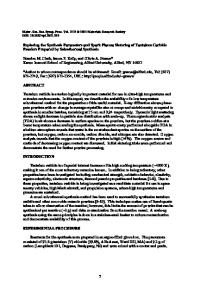Electric Field Enhanced Synthesis of Nanostructured Tantalum Carbide
- PDF / 229,426 Bytes
- 5 Pages / 612 x 792 pts (letter) Page_size
- 47 Downloads / 320 Views
Nanocrystalline TaC was synthesized by the field-activated combustion method. The crystallite size ranged from about 30 to 55 nm, depending on the applied field. At low fields (8.54 艋 E < 16.39 V cm−1) the average crystallite size was relatively unaffected by the field, but it showed a significant increase at fields higher than 16.39 V cm−1. From temperature measurements, this field was found to coincide with the melting of Ta. The combustion wave velocity likewise showed a significant increase when the temperature was at the melting point. The composition of the product showed a dependence on the magnitude of the applied field. At low field values (above a threshold) the product contained Ta2C. When synthesized at high fields, the product showed the presence of TaC phase only. The lattice parameter and the C/Ta ratio showed a slight dependence on the field, both increasing with an increase in the magnitude of the field. I. INTRODUCTION
In previous investigations we reported on the effect of an externally imposed (contacting) electric field on the microstructural evolution during product formation in self-propagating combustion synthesis.1,2 In the case of MoSi2, it was observed that an increase in the magnitude of the applied field resulted in a decrease in the grain size of the product up to a certain field level; above that the grain size increased with increasing field.1 The decrease in grain size was interpreted in terms of reduction of grain growth due to a decrease in residence time resulting from the steep temperature gradients generated by the application of the field. The application of a field has been shown to result in an increase in the temperature and velocity of the combustion wave3 and thus the cooling rate of the resulting product. The observed increase in grain size at higher fields corresponded to temperatures at which the product is molten.1 Results of a recent study provided additional support for this. In the synthesis of TiC–TiNi composites, where the matrix alloy (TiNi) is molten under synthesis conditions, the grain size of TiC increased with an increase in field strength.2 To investigate the effect of the field under conditions where no liquid phase would exist, we selected the synthesis of TaC. The adiabatic temperature for this compound is lower than the melting point of the reactants (Ta and C) and the product, and thus only solid-state reactions are anticipated. a)
Present address: Department of Chemical and Materials Engineering, San Jose State University, San Jose, CA 95192-0082. b) Address all correspondence to this author. J. Mater. Res., Vol. 17, No. 3, Mar 2002
http://journals.cambridge.org
Downloaded: 08 Apr 2015
Tantalum carbide, a predominantly covalent-bonded compound with an NaCl structure, is stable over a relatively wide range of substoichiometry. Values for the lower limit range from TaC0.58 to TaC0.74. The upper limit extends to at least TaC0.99 at 2400 °C with a trend to higher carbon contents as the temperature is lowered. The lattice parameter, a ⳱ 0.4441 nm for
Data Loading...









